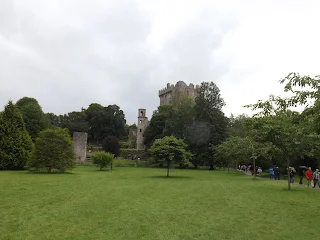The very name, Death Valley, conjures up images of people struggling through the vast desert east of the Panamint Range, with temperatures soaring during the summer upwards of one-hundred-twenty degrees. The hottest temperature on earth was actually recorded in Furnace Creek in Death Valley on July 1st, 1913 at a blistering one-hundred-thirty-four degrees. It was so warm that it was reported that birds fell out of the sky dead littering the ground.
Yikes - that is mighty hot!
We felt pretty cool and comfortable in the mere one-hundred-seven degree temperature as we tooled past Furnace Creek on our way north to the ghost town of Rhyolite which sits on the eastern edge of the Death Valley just inside the western border of Nevada.
Our destination was the once booming mining town with the Bullfrog Mining District which had its beginning on August 9th, 1904 when Frank "Shorty" Harris and Ernest "Ed" Cross discovered a rich gold deposit on the south side of a southwestern Nevada hill later to be named Bullfrog Mountain. The ore was so rich, $3,000 a ton which would be nearly $77,000 a ton today that thousands of hungry yellow metal seekers soon moved into the area looking for their fortunes.
By 1907 over 4,000 people called Rhyolite home which boasted concrete sidewalks, electric lights, water mains, telephone and telegraph services, a public swimming pool (a good idea in that heat), three banks, stock exchange, opera house, churches, as well as daily newspapers. A full police and fire department took care of any emergencies which may have occurred within the bustling and growing town in the middle of a vast and extremely brutal desert.
But as soon as the boom had boomed the fall came. With a major devastating earthquake in San Francisco in 1906 which diverted capital away from the mines to the south, disrupted railroad services and other financial concerns the town quickly started to slide into a depression. It also didn't help that the mines seemed to have been 'played' out by all those gold seekers.
In 1910 only 675 people still remained in the borders of Rhyolite and soon those too left for greener pastures and by 1922 the Los Angeles Times reported only one ninety-two year old man called the once prospering town his home.
Today there are only partial buildings to remind one of the what this old mining town must have looked like but with a little imagination it is easy to stand in the streets looking at the ghosts of the past. To truly see hundreds of citizens proudly walking up and down the sidewalks of their gem of a city in the middle of nowhere going about their daily activities.
 J of J and L, rumored to have a vivid imagination, swore he saw a lovely couple dressed in their finest strolling near the ruin of the opera house hand in hand and smiling into each others eyes.
J of J and L, rumored to have a vivid imagination, swore he saw a lovely couple dressed in their finest strolling near the ruin of the opera house hand in hand and smiling into each others eyes.Perhaps it was only his imagination but then again, perhaps it was not.










.jpg)
.jpg)